My Experience with Erector Sets
Boys Should be Boys!
All About A.C. Gilbert

A.C. Gilbert Made Millions by Feeding the Dreams of Young Boys
Do you think they believed that the set would allow them to build something that big?

Join Us on Facebook
This page presents a brief summary of the life of Alfred Carleton Gilbert, a remarkable man who influenced a whole generation of Boys.
Click on a Box to Go There

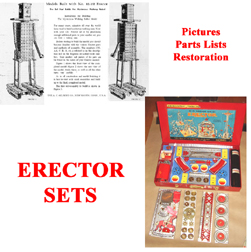
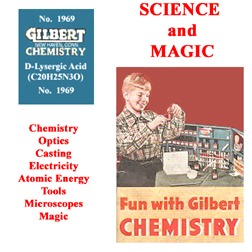
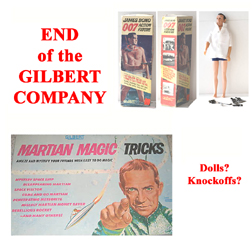
Some of you (i.e. folks coming in from Search Engines) have a very focused need for information. We have specially prepared the following list just for you.
All About A.C. Gilbert [THIS Page]- Who was A.C. Gilbert?
- How did A.C. Gilbert sell things to Boys?
- What was Gilbert's Competition like?
- The Gilbert Appliance Business
- Mr. Gilbert Patents the Vibrator
- How can I learn more about A.C. Gilbert?
- Rationale for the Erector Set in the 21st Century
- Contact me about something
Erector Sets [Separate Page]
- What is this 1/2 Business?
- A Slide Show From the "How-to-Make-em books"
- Pictures of MY Erector Sets
- My Experience in Restoring Erector Sets
- Erector Patents
- Free Download Stuff
- Contact me about something
Science Kits [Separate Page]
Brief look at Chemistry, Microscope and other Science Kits
- The Gilbert Chemistry Set
- The Gilbert Atomic Energy Set
- The Gilbert Microscope Set
- The Gilbert Electric Eye Set
- The Gilbert Metal Casting Set
- The Gilbert Air-Kraft Set
- The Gilbert Glass Blowing Set
- The Gilbert Machine Gun
- The Gilbert Optics Set
- The Gilbert Hydraulics Set
- The Gilbert Signalling Set
- The Gilbert Magnetism Set
- The Gilbert Soldering Set
- The Gilbert Erector Brik Sets
- The Gilbert Big Boy Tool Sets
- The Gilbert Elementary Electricity Set
- The Gilbert Lighting Set
- 66 Stunts With an Electric Motor
- Mysto Magic Sets
- Dexterity Puzzles
- Contact me about something
- The Gilbert Atomic Energy Set
The End of the Gilbert Company [Separate Page]
The Last Days of the Gilbert Company
- The Gilbert Chemistry of Plating and Paints Set
- The Gilbert Pottery Set
- The Gilbert Slot Car Set
- Moon McDare Action Figure
- James Bond Action Figure
- Honey West Action Figure
- U.N.C.L.E. Action Figures
- Martian Magic Set
- Model Airlanes
- Gilbert Watches
- Contact me about something
Those with a general interest should just keep scrolling down
So what does this have to do with Swing Dancing? (Those of you who came here from a search engine should know that this is primarily a dance website...) The answer is simple: "This is a toy that shaped generations of men, particularly those of the Swing Generation." And "Why," you may ask, "Did this thing have such an influence?" Look at this:

The Boy's Dream
Home, Hearth, Parental Approval
This is one of the very first ads for the Erector Set. Please note that the young boy, before the blazing hearth, is building an ENORMOUS bridge in the middle of his parents' living room. Little brother helps out, Mom and Sis admire him and Dad is enraptured by the work. Anything that would promise this level of familial approval had to be a hot seller. And this was it - no father ever (EVER!) got down on his kids for building things with an Erector Set. Construction work, either as a laborer, engineer or architect, was a big ticket item for all classes. Plus, there was absolutely nothing in the Erector set that could be used for obvious antisocial purposes. (See chemistry sets, on our "Science kits" page) These things would keep children busy for hours as tiny hands fumbled with the bolts and nuts. The only downside was that you really DID have to have some engineering skills to make some of the bigger models, particularly those that required figuring out complicated gearing ratios for the motor. The latter part offered a role for Older Brother or Dad, promoting family harmony. My Dad was never too busy to help with an Erector project, although he avoided my trains and model airplanes like the plague.
Let's fast forward to 1957, when I was 13 and very vulnerable to the Erector pitch. This was also the Year of Sputnik when (for a very short moment) it was "cool" to have good grades and to be interested in science. For a month or two, my Dad even stopped referring to me as his "mad scientist son" to the guys at the corner bar.
The Gilbert Company used the national awareness of Science in an advertising comic book called Science Leads the Way
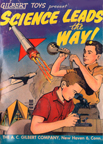
Science Leads the Way
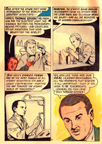
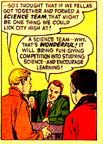
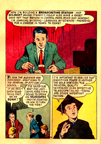
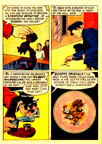
Small Town Kids Beat the Big City Smart-Alecks Thanks to Gilbert...
Incomprehensible as it may seem in 2010, Big City Schools were the best in 1959...
The comic (far right) also provides a foretaste of the CSI series...
Click to Enlarge
Although the comic is quite fanciful, it provides one interesting sociological observation. In the 1950s, the Big City schools were the best in the nation. People from outlying communities would have their child board with a city relative to obtain entrance to the Good Schools. When I was a kid, I would look at the science laboratories in the city schools with awe. In 2010, the notion that City Schools are a vast reserve of knowledge about anything other than drug dealing is an absolute hoot. In spite of zillions of dollars tossed at them, most city schools can't even get their teachers to read at 8th grade level.
I expect to hear outraged howls from the teachers' unions along with the chorus of Concerned Moms, so I'd better stop. Although, maybe the Concerned Moms might want to take on the Unions -- they can use their Lawyers to keep kids from putting Erector set parts in their mouths, but they don't use their Lawyers to keep the schools from putting condoms in their hands (or heroin in their veins)... I would also like to see the Friends of the Wolves duke it out with the Friends of the Deer...
We have scanned this comic and make it available to you, free of charge. Just click on the hyperlinks below; be sure to "save" the document on your machine before opening it!
Gilbert used this theme in the mass media as well. Here's an ad from Boys Life, every 13-year-old's journal of reference:
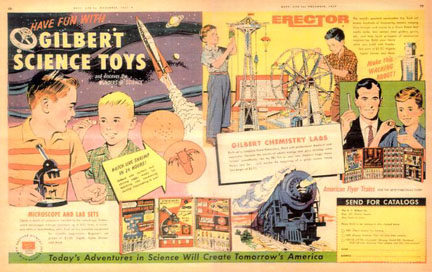
The Reds are Bad! Science is Good
America's fascination with scientsts lasted just until John Glenn went into orbit...
As you can see, all of these All-American boys are having a wonderful time playing with their varied A.C. Gilbert toys. I had most of them, the Microscope kit, the Chemistry set, but not American Flyer trains (We were a Lionel household...) More on these other toys later. Note that the "Walking Giant" is manifesting himself in the upper right hand corner. In order to build Mr. Giant, you had to have the "Number 12 1/2" set. (More about those 1/2 things below). This cost $70 dollars when $1 an hour was a good wage; the mortgage for most people was $70/month. As near as I can figure it, this thing would cost about $2,400 in today's dollars. Needless to say, the "Number 12 1/2" set remained out of my grasp for a LONG time.
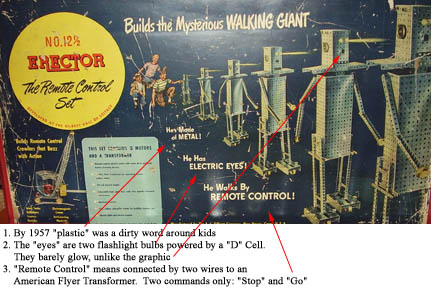
Mr. Giant is more "show" than "go"
This graphic really touches on the 12-year old boy's mind
A.C. Gilbert was a Princeton and Yale scholar, won a gold medal the Olympics in the pole vault, and was a phenomenal businessman. It could be said that he truly "knew boys." Everything that he did or made appealed to the curiosity and fantasies of boys aged 6-16. He made a fortune.

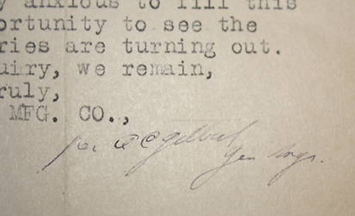
Letterhead and Gilbert Signature from the "Mysto Magic" period
Click to Enlarge
Gilbert began his connection with the Toy industry by pursuing his favorite vocation -- as a Magician. Although he was a Yale-trained doctor, he began pursuing a career in Magic. he was so good at it that he was asked to join the "Mysto" Company that made and distributed "Magic Sets" to kids, teaching them elementary illusions. Gilbert lived in New Haven, but commuted regularly to New York to fulfil his duties to Mysto. As he rode on the train, he observed the steel structures being created to hold the wires for the new electric locomotives. These structures, made of a latticework of girders, were the inspiration for the Erector set.

Girders on New Haven Railroad That Inspired the Erector Set
Click to Enlarge
When the government tried to prevent him from making Erector Sets during World War One (October of 1917), he went to Washington and made the case that boys with Erector experience made better soldiers. For this reason, he is known as The Man Who Saved Christmas. There was a made-for-TV movie with that name, but Jason Alexander (the Seinfeld's sidekick) was cast as Gilbert.
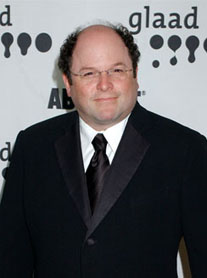
(l.) A.C. Gilbert in Princeton Athletic Regalia (r.)Jason Alexander
Do these guys even remotely resemble each other???
Indeed, the Erector Set was the ideal Christmas gift for the Boy, adding parental approval to the Boy's dream of adulthood.


The Erector Set and Christmas
1927 Letter to Santa, 1949 Advertisement
"The One Big Present He Looks Forward To"
Click to Enlarge
While he was saving Christmas with Erector Sets, Gilbert also manufactured wind-up toys. Here, from the critical period in the war is the 1917 World War motorized Ambulance Toy. The crank on the front is used to wind the spring for the motor. It is supposed to have a driver, but we have never seen one. The ambulance is 8 1/2" long. We suspect that the rear door has been replaced. The Lindstrom Co made a very similar toy van without the the oval windows.
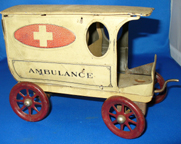
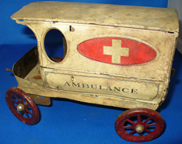

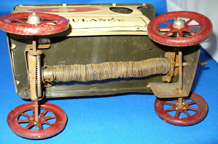
The Wind-Up Ambulance
The Crank Winds the Motor
Click to Enlarge
Thanks to our friend Gale Wollenberg in Kansas, we have some photos of the No. 4 and No.4a Erector Sets that were being sold at the time Mr. Gilbert "Saved Christmas". As you can see, they weren't very complicated, although it is claimed that you could make "over 400 models" with each set. The two sets also feature the P-58 motor (69 parts) that had to be assembled by the Boy.



"Found Condition" Gilbert No. 4 Set



"Found Condition" Gilbert No. 4a Set
Click Here to see a restored No. 4a Set
The Sets were housed in an oak box
Click to Enlarge
Here is a video that describes a similar set in more detail:
Here is an ad from the 1930 Sears Catalogue that shows the general variety of Erector sets that were available. The accompanying table show the discout that Sears was offering over the "normal" retail price, and an estimate of the cost of these toys expressed in 2009 dollars. We also note that Sears gave the heaviest discounts to the most and least expensive sets, probably because these were less likely to sell (the former because it didn't make many projects and the latter because it was quite expensive)
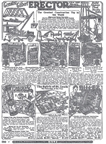
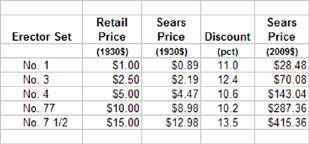
From the 1930 Sears Catalogue
The Expensive Set was a "bargain"
Click to Enlarge
Mr. Gilbert focused in on the Boys need to win approval from Dad, Mom, and Pals with the Freudian zeal. This advertisement for the chemistry set invokes the wonder of modern science but brings it home by saying "... Imagine Dad's surprise when you make a compound that will keep his windshield from fogging in rainy weather. Picture mother's amazement when you make iodine .. Think how your Friends will gasp when you turn a lemon into an electric cell...".

The Magic of Science
...and Parental Approval...
Click to Enlarge
Gilbert was also careful to provide a delicate balance of Science and Sports, making sure that the Gilbert world was diffrerent from school. Here's an ad for the "Big Boy Tool Chest":
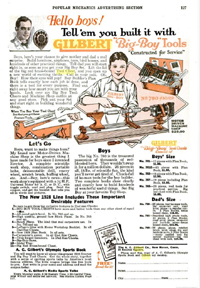
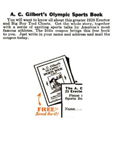
The Subtle Sports Pitch
Click to Enlarge
Once again, the familiar theme of Dad, Mom and the Pals is repeated: "BOYS! Here's your chance to give Mother and Dad a real surprise. Build furniture, airplanes, toys, birdhouses, and hundreds of other things... Lift the lid of the big red brass-bound Tool Chest and you open up a new world of exciting thrills. Call in your pals. Oh, boy! How their eyes will pop!..."
BUT, that was only the opening sales pitch for the Gilbert "Big Boy" tool chest. But you'll that, hidden in the lower left corner is an offer for a free book about the Olympics. Recently, we obtained one of these books. This is a pretty dry compilation of records, but it reminds The Boy that Mr. Gilbert was an Olympic Medalist, proving that you can be a scientist, businessman, and athletic he-man at the same time.

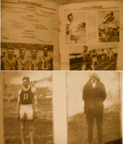
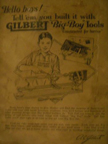
Excerpts from the Olympics Book
Note that it continues the sales pitch...
Click to Enlarge
The Gilbert Company also made good use of the Boy's natural competitive instinct. They regularly held contests of all sorts, especially for new and astounding models that could be made with the Erector Set. Here is an ad for a contest that offered either a trip to the Panama Canal or a Free Car!

Win a Trip to the Panama Canal
Or a New Car...
Click to Enlarge
During the mid-1930s, the company published a magazine called Gilbert Thrills that presented contemporary feats of engineering to wide-eyed boys. Of course, the ads reminded the Boy about all the things that he could construct on his own with a Gilbert construction kit.
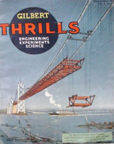
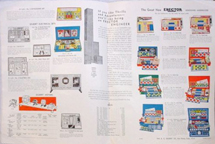
Gilbert Thrills Magazine
Engineering for Boys
Click to Enlarge
This magazine was also used to announce the results of the various contests that were held during the year. Of some note is a third-prize "Honorable Mention" prize of $10 given to Hughes Powell of Texarkana, Texas for "...Creation of Artificial Life..." If this is true, the competition must have been really fierce in 1936!
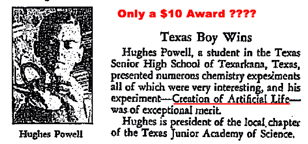
Third Prize for Chemistry
... Artifical Life???
...this has not been Photoshopped!
Click to Enlarge
I was very pleased to see that Mr. Gilbert was quite fair (for 1936) in that one of the prize winners was African-American, another from "Paris, France", and another was ...a girl!
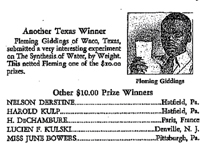
Other Chemistry Prizes
It looks like Hatfield Pa. had more science going on than Paris...
Click to Enlarge
So that you may enjoy the rest of this exciting issue, we have scanned it in and it is available in the Free Downloads Section, in five packages of about 3 MB each. Enjoy!
During World War II, the Gilbert Company did not try to save Christmas. In the face of overwhelming threats from Japan and Germany, the Gilbert factory went into full scale production of war materiel. Here is a good example of this -- a naval range finder. In addition, the company made machine gun parts, flares, parachutes, triggers for mines and the like, all of which can be traced back to one or another of the items manufactured for the various toys and kits.

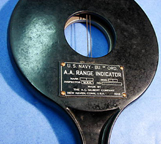
World War II Naval Range Finder
Click to Enlarge
During and after the war, it was difficult for the Gilbert company to obtain steel. Gilbert produced this Erector Junior No. 5 in 1945. In our detailed discussion of Erector Sets we'll see that Mr. Gilbert was outmaneuvered in seeking steel priorities in the post-WWI economy, leading to the emergence of the "Constructioneer" competing system. The artificial advantage did not last and Gilbert attained prominence in selling Construction Sets during the 1950s.
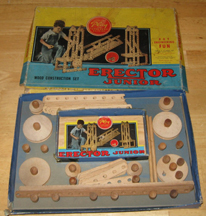
The All-Wood "Erector Junior"
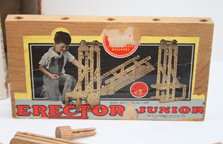
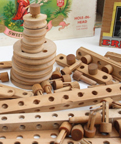


Details of the Wooden "Erector Junior" Set
Alas, by 1954 the Erector Junior was made of safe, "gay-toned" plastic
Click to Enlarge
In 1953, Mr. Gilbert was featured in an article entitled "Fortunes in Toy Ideas" that appealed to the basement inventors who formed the reader base for that magazine. You may Click here to read a ".pdf" of the article. Although Gilbert's picture leads off the article, you don't hear about him until the next to last paragraph. Of all things, an Erector Set ad is directly next to this paragraph -- product placement, 1953 style.


A.C. Gilbert Featured in Nov 1953 Popular Mechanics Article
Right: Erector Set ad from the same issue
Click to Enlarge
When Mr. Gilbert passed away, the company was continued by his son. Unfortunately A.C. Gilbert Jr. was just "Al" and never "Mr. Gilbert." The impact of Television was pronounced and many of the Gilbert products seemed to be hopelessly out of date. Various attempts were made to "modernize" the product or to create tie-ins with popular television programs and films. The company moved away from its identification with the "boy" and met an ignomous end by selling Dolls (i.e. "action figures") to Boys.
From the beginning, Mr. Gilbert addressed his ads to the ideal Boy -- a person who could be challenged to do great things. Mr. Gilbert provided the Boy with tools and projects that allowed the Boy to fulfil his fantasies of adult achievement. The Erector Set and American Flyer trains were advertised by appealing to the Boy's desire to construct his own little world.
Gilbert sold toys on the basis that they were "Just like real [chemists, engineers, carpenters, etc} use." As you will see, ads for Gilbert products stress that they are a serious representation of glamorous adult activity, maybe only a bit smaller. Ads were notorious for misrepresenting the scale of projects that could be made with an Erector Set. To a degree, Gilbert toys were head and shoulders above the competition in flexibility and in the intellectual content of accompanying books and manuals. These materials are so well-written that I offer some of them as downloads so that you can form your own opinion about their quality. Gilbert may have exaggerated, but he never talked down to the Boy.
His ads encouraged the Boy to believe that his parents would be pleased when he used the toy to construct useful things. He promised that the Boy's peer group would be thrilled with his toy. "Imagine how their eyes will pop when they see the big red brass-bound chest," read an advertisement for a Gilbert "Big Boy Tool Set."
Thus, having approached the Boy with Role Play, Parental Approval, and Peer Group Recognition, Mr. Gilbert never forgot that the Boy had other interests. He encouraged all Boys to occasionally put down their toys and play at sports. Often his ads offer a sports-related premium for purchases.
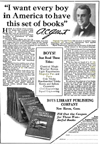
Boy Engineering from the 1921 Popular Mechanics
Click to Enlarge
In addition to all of this, the Gilbert Company wrote very clear and understandable manuals to go along with the science and construction kits. These books, advertised above as the "Boy Engineering" series never talked down to the Boy. I have made a point of collecting these and I have placed those that I have found on this site for you to read. These include:
- The Chemistry Manual
- The Microscope Manual
- Instruction Manual for the Electric Eye Set
- Fun With Electricity
- Dagwood Splits the Atom
- The Glass-Blowing Manual
- Boy Hydraulics and Pneumatics Engineering
- Signal Engineering
- Optics and Light Engineering
- Carpentry for Boys
- Part One: Introduction, Types of Wood (pp 1-13)
- Part Two:Finishes, Chisels, Saws, Planes (pp 14-27)
- Part Three: Drills, Hammers, Fasteners, Joinery (pp 28-41)
- Part Four Plans (pp 42-55)
- Part Five Plans (pp 56-69)
- Part Six Plans(pp 70-83)
- Part Seven:End Notes and Ads (pp 84-End)
Mr. Gilbert had a wide variety of contests, broadcasts, and membership clubs that gave the Boy a place to Belong. He opened the Gilbert Hall of Science in New York as a Mecca for Boys. Here are pages from a comic book/ad from the 1950s. The story begins when the Boy is bored witheverything while Dad (the guy with the mustache) frets about ways to move the Boy onto a productive career track. Dad finally drags Boy to the Gilbert Hall of Science and places him in the hands of a smooth shaven "Space Traveler" who proceeds to show the Boy all kinds of amazing things involving Chemistry, Engineering and Astronomy. Interspersed with these feats of magic are full page ads for the products being used in the comic strips.

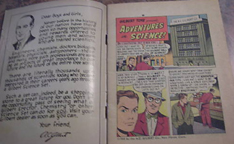
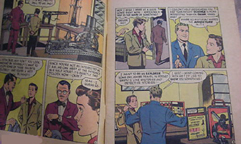
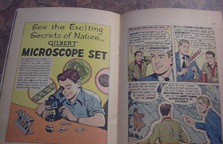
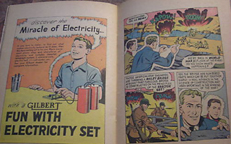
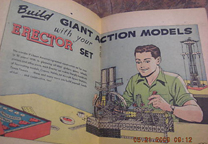
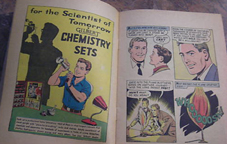
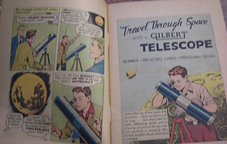

Click to Enlarge<
Click to download the entire Adventures in Science Advertising Comic Book
Thousands of Boys wrote regularly to Mr. Gilbert, confiding in him as a second father. Gilbert took pride in saying that he had "thousands of sons." Alas, Mr. Gilbert was not that close to his own family, but that's another story.
One of Mr. Gilbert's best kept secrets was that he made Girls' Toys. This may come of a shock to those of you who may have bought into the "Boys!" advertising line. The truth of the matter was that Mr. Gilbert was eager to get into any business that made money, especially one that would keep his factories busy. Mr. Gilbert set up the LaVelle Toy Company as a separate entity and went through some accounting gymnastics to keep LaVelle completely separate from the Gilbert enterprise. This was "separate" only in the legal sense. The LaVelle offices were located on Fox Street just behind the main Erector plant.
The name "LaVelle" was selected because it was the name of Mr. Gilbert's sister-in law, wife of his brother Frank W. Gilbert. Lavelle toys were manufactured during the mid 1920s and were targeted at "traditional" or "stereotyped" female roles, such as the "Little Laundress" kit and others shown below. Thanks to Randy Sauder for help with the origins of the name "LaVelle" and photos of the ultra-rare LaVelle kits
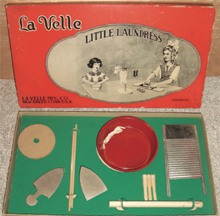
LaVelle "Little Laundress" Set
Image courtesy of Randy Sauder
Click to Enlarge

LaVelle "Millinery" Set
Image courtesy of Randy Sauder
Click to Enlarge
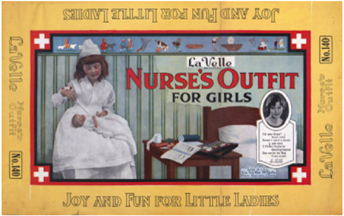
LaVelle Nurse Set
Image courtesy of Randy Sauder
Click to Enlarge
Mr. Gilbert also entered the children's record business, which was highly competitive. Gilbert's record lable (Bob-O-Link) was accused of price manipulation to obtain market share. Both LaVelle and Bob-O-Link lines were dropped in the late 1920s.
I'd like to take a minute to show some "other" toys so that you can contrast them with the Erector Set. It was customary for the Science and Mechanics magazines to publish an article on "New Toys" in their December issue. I have managed to find three of these: 1931, 1946, and 1952. Take a look at them and decide for yourself whether (or not) the Gilbert construction and science sets were really a "cut above."
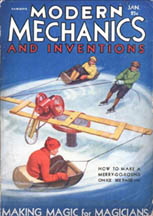
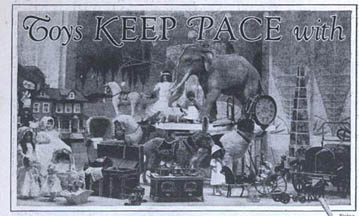
The 1931 Toy Preview
From the "January" 1931 Issue of Modern Mechanics
Modern Mechanix Issues were dated by the time they would be removed from the newsstand
That is, the January 1931 issue would be on sale during December 1930 up to January 1 1931
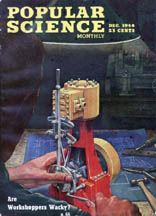
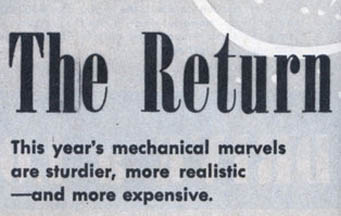
The 1946 Toy Preview - First New Toys after WWI Restrictions Were Lifted
Gilbert Chemistry Sets and American Flyer Trains Got a Special Mention
From the December 1946 Issue of Popular Science
Popular Science Issues were dated by the time they were offered on the newsstand
That is, the January 1946 issue would be on sale during December 1946 and would be removed on January 1 1947
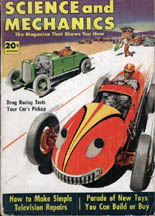
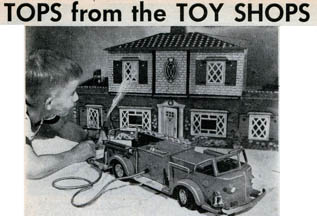
The 1952 Toy Preview
From the December 1952 Issue of Science and Mechanics
Science and Mechanics Issues were dated by the time they were offered on the newsstand
That is, the December 1952 issue would be on sale during December 1930 and would be removed on January 1 1953
Click on any photo to Enlarge It
Read the 1931 article
Read the 1946 article
Read the 1952 article
Occasionally, files held on the server may be corrupted-- if you find that this is the case with your download, please contact me and I'll send you the correct file.
Since the Toy Business was quite seasonal, Mr. Gilbert used his factories to manufacture a number of household appliances. Among the most recognizable were the Polar Cub Fans, an item that could be made in the winter and sold in the Summer, just as toys were made in the summer and sold (mainly) at Christmas.
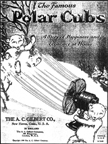

Polar Cub Fan Ad and Patent No. 1,780,789

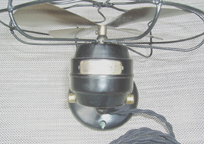
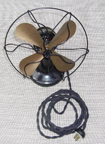
The Polar Cub Fan
Click to Enlarge
Of some note is the Dari-Rich Blender, as shown below. Many folks believe that this is a "milk shake mixer". While it could be used for this purpose, it was patented and sold to individual households before most of them could afford a refrigeratior. In fact, the "Dari-Rich" was marketed in the 1920s to reconstitute powdered milk. Although powdered milk had been manufactured by the Chinese as early as 1275 AD, and patents for drying as early as 1835, packaging milk powder for long shipment and storage was not developed until the beginning of the 20th Century. The most effective [Heath] process for packaging milk powder in a safe and sanitary manner dates to 1920.


Both Ends of the Powdered Milk Cycle
Heath's Powdered Milk Packaging and the Gilbert Reconstituting Mixer
Patents No. 1,406,380 and 1,407,789
(Click here for a more detailed history of powdered milk in the 1920s.)
Click to Enlarge
For many families, powdered milk was one of the few options for providing wholesome milk to children on a daily basis, since refrigeration was severely limited. Since milk is an emulsion, simple stirring will not disperse the solids properly, leaving a gritty taste and clumps at the bottom of the glass. Further, even slight variations in drying temperature may caramelize the milk albumen, giving a "boiled" taste.
Not long after the mass-marketing of powdered milk, the Gilbert company purchased a patent from Oscar Erhardt for a portable mixer. Mr. Gilbert's blender was then as important on the consumer end as Mr. Heath's patent was on the production end, enabling families to enjoy properly reconstituted milk (with additional flavoring to make up for deficiencies in the dehydration process.) However, the patent also contains another clause that would lead to further development of the Gilbert appliance lines:
"... The primary object of the invention is to provide a simple, efficient, readily portable beverage mixer. More particularly, it is aimed to furnish a device in which the motor is not limited in its use to beverage mixing purposes, but can be readily detached from the other parts of the apparatus when it is desired to employ it for other purposes ..."
Eventually, the portable mixer morphed into the Dari-Rich that became a runaway best seller. Some Gilbert enthusiasts even suggest that this may be one of the companies largest selling appliances. Here are some photos of one of the more "mature" versions:

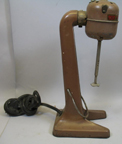


The Dari-Rich Reconstituting Mixer
Click to Enlarge
Following on the heels of the Dari-Rich, Gilbert Company eventually made kitchen appliances such as the stand mixer shown below. Mr. Gilbert, himself, is listed as the inventor on one of the patents (No.2,027,036).
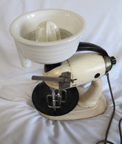

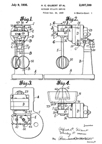

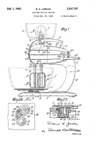
The Kitchen Stand Mixer
Patents No. 2,007,300, 2,027,036, and 2,247,708
Click to Enlarge
In addition to earning a medical degree from Yale, an Olympic Gold medal, the worlds championship in chin-ups, and building a multi-million dollar company, Mr. Gilbert also invented the sex toy.
Whether it be fan, mixer, or blender Gilbert's appliances were just an electric motor hooked to something. Note that one of the key points of Erhardt's blender patent (above) is that the motor can be used for "other purposes". Below, you will find Mr. Gilbert's patent No 1,668,364 (May 1, 1928) for The Vibrator, indicating that by 1927 or so, he had discovered yet one more "other" purpose.
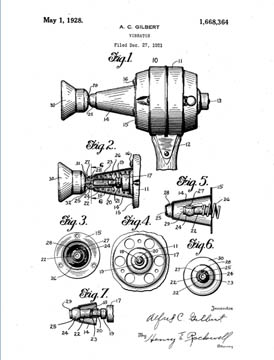
Patent for a "Vibrator"
Click Photo to Enlarge It
You'll note that the Vibrator was patented after the Dari-Rich, but before the Fan and quite a bit before the stand mixer. Clerly, Mr. Gilbert had the vibrator in his thoughts early on in the electric appliance business.
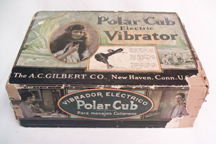
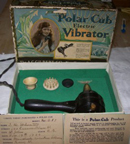
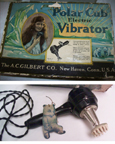

Elegant Packaging in the Best of Taste
The Polar Cub hang tag is exceptionally rare.
Optional plugs were provided
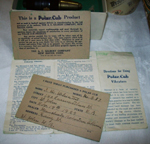
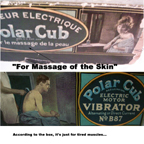

A Very Early Polar Cub Vibrator
Notations in French
Cures "nervousness" and "develops the bust"
Click Photo to Enlarge It
At the time this vibrator was produced, there was little standardization in the electricity industry. Some homes were wired from the attic through the ceiling and had light sockets hanging down. Appliances had to be connected with a screw-in plug that looks like the base of a light bulb. Other houses were wired from the basement through the floor and used the now familiar two-prong plug. Mr. Gilbert gave the customer both. (just in case the boudoir had been wired from the attic...)
Here are photos of a copycat device manufactured by the Bersted Company, the "Knockoff Kings.".
The Eskimo Vibrator
Check out our Web Page on More of Mr. Bersted's knockoffs
Your first reaction (as was mine) was probably something like "This is a thing for sore muscles." Certainly, the box for the Eskimo vibrator would lead you to that conclusion...
Au contraire, records from the Gilbert company indicate that this thing was intended for another part of the body. According to Bruce Watson (op. Cit), there is a nine-page document in the Gilbert archives that describes this appliance and its purpose:
"... One object of the invention is to provide a means by which married people can enhance sexual excitement with each other so as to enjoy completion of normal sexual intercourse with the least expenditure of time and energy..."
The document goes on to describe the function of body organs and glands (Gilbert was a Yale M.D.), ending with:
"... without proper stimulation... sex can become a chore. and every excuse is used to avoid this obligation ... the vibrator is the quick and simple solution..."
Apparently (according to Watson), Gilbert field tested the gadget amongst his friends and reported:
"... all couples have admitted that their sexual retationships have immesurably improved. Husbands feel proud of their new ability to satisfy their wives. Small and picayune differences are quickly thrust aside. The Wife is now extremely happy and content with marital life. The Husband is proud of his new prowess ..."
A little bit of Internet research has revealed that the first vibrator could have been made in the 1850s and was steam powered (perhaps it came with a notation on the crate "Coal not included.") From my limited experience with steam engines, this was not something that a lady might use for a quiet interlude. Most Internet sources credit a British physician with inventing a wind-up version of the vibrator in 1880. I can imagine a moment of Victorian ardor in which the thing runs down and has to be rewound at a critical moment (possibly accompanied with fumbling for the key...) So, Mr. Gilbert is, more properly, the inventor of the electric vibrator.
From this point, a discusssion of the vibrator becomes clouded by Feminist politics. A number of Internet sources are noticeably hostile in discussing the issue. One source seeks to remove the vibrator from the nightstand drawer to a prominent place on the coffee table. I didn't find anyone arguing against the vibrator, so Mr. Gilbert has probably done the world a net good by inventing the gadget.
These wren't intended just for the ladies, either. I found this ad for what appears to be a dead-on knockoff of Mr. Gilbert's invention being touted as a treatment for prostatitis. It appeared in the October, 1949 issue of Detective World, a less-well-known journal of scientific fact:


The male equivalent of the "cure for sore muscles"
From the October 1949 Issue of Detective World
Click on Either Photo to Enlarge it
Apparently, Mr. Gilbert knew boys and girls.


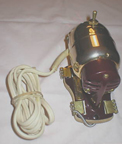
The Hand Vibrator
Click to Enlarge
Here is a more "normal" vibrator manufactured by the Gilbert Company. Apparently, Mr. Gilbert also knew sore muscles.
You have a whole lot of choices about ways to learn more about A.C. Gilbert and his fascinating life, business strategy and products.
Check out these Links
I'm not going to say much more about Erector history because there are a large number of very well-written and informative websites out there. The best is the A.C. Gilbert Heritage Society that covers the full breadth of products made by the Gilbert company. A good site that specializes in construction sets is Girders and Gears. Each of these sites has a "links" page that will direct you to more megabyytes on Erector Sets than you could consume in a lifetime. These guys are the experts. If anything that I say here contradicts them, they are right. If you want to look at actual American Flyer or Erector catalogues from the 1940s and 1950s (and download them), check out MyFlyerTrains.
Check out Erector Square in New Haven, Connecticut
Mr. Gilbert never moved from New Haven. His factory at #486 Blechley Avenue (Corner of Bletchley and Peck) still stands, although it has been chopped into a variety of small businesses, several having to do with fitness and yoga.
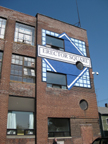

Erector Square, c. 2010
Click to Enlarge
Here is a map and aerial photo to help you out:
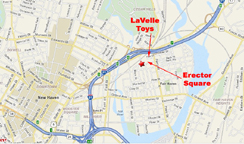
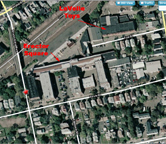
Map Showing the Gilbert Factory in New Haven, Connecticut
Note that the LaVelle Toy Co. Adjoins Erector Square...
Click to Enlarge
Note that the LaVelle Toy Company on Fox Street is just behind the Erector Complex. Mr. Gilbert went out of his way to keep his connection with Girls' toys very distant from the Erector mythology, but very close at hand for manufacturing and distribution efficiency.
Visit the Eli Whitney Museum in New Haven, Connecticut
The Eli Whitney Museum is devoted to the study of invention and innovation in industry. Most of the space is devoted to Eli Whitney and his methods of standardized mass production. However, there is space devoted to New Haven's other commercial genius, A.C. Gilbert. I visited the museum in the summer of 2010 and had a wonderful time chatting with the staff.
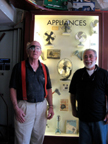
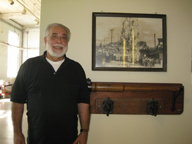

At the Eli Whitney Museum
left: the staff were very informative
middle: with Mr. Gilbert's Chinning bar where he set the world record
right: Mr. Gilbert took time from his morning workout to pose
Yes, that is his correct height...
Click to Enlarge (the photos, not Mr. Gilbert)
The exhibits spanned the many and varied items that Mr. Gilbert sold in his years at Erector square.





Displays of Gilbert Products
Click to Enlarge
The Musum also displays some of the most famous Erector models including the Ferris Wheel and the Hudson Locomotive and Tender:
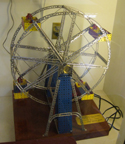
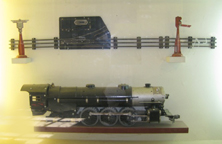
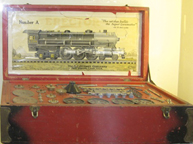
Displays of Gilbert Products
left: Ferris Wheel; middle: No. 81/2 kit with Hudson
right: Hudson locomotive and Tender assembled
Click to Enlarge
This is a great way to spend a couple of hours.
Read what others have to say about A.C. Gilbert.
There is a five page article in the November 18, 1946 issue of LIFE Magazine entitled "Alfred Carlton Gilbert, Toy King." I have obtained this issue and scanned it for you.
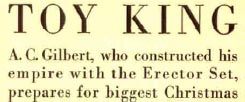
Headline from the 11-18-1946 LIFE Magazine Article
Read the 1946 LIFE Magazine Article
The Erector Sets were always popular toys that kept boys interested. They were a radical departure from the run-of-the-mill single purpose toys that had generally been offered to children.
Gilbert's methods of instruction were the inspiration for at least one doctoral dissertation. We have obtained a scan of "The Educational Value of Certain After School Activities", a 1921 dissertation.

Dissertation on Gilbert Methods
Click to Download the ".PDF"
Occasionally, files held on the server may be corrupted-- if you find that this is the case with your download, please contact me and I'll send you the correct file.
A.C. Gilbert is revered by legions of Boys who never met him -- mainly because his advertising campaigns placed him in the role of an Ideal Father. This view has been challenged. You might want to look at another side of the Gilbert enterprise as presented by Craig O'Connell
Thanks to the Reverend Arnold Taylor, I have come into possession of a marvelous book:
Viking, New York (2002), ISBN 0-670-03134-8.
Read the review of Bruce Watson's Book
Sadly, the Erector Sets of yore could not be sold to children today -- the parts are painted with lead-based paint and the vast array of "small parts" might be a choking hazard. Worse yet, these toys foster individuality -- the Boy had to read the blueprints and figure it out for himself. There were no androgynous committees of well-socialized tykes to put these things together. If you had to ask for help, you were a schmuck, a dolt, a doofus, or a weenie and you probably tried to get out of gym using allergies for an excuse. Today the Nanny State (Lawyers, Bureaucrats, the Public Schools, and Concerned Moms) seems like it is organized to prevent Boys from being self-reliant.
I'd like to take a minute to take a look at what can happen when the Nanny State keeps Boys from being Boys. Most of the good things that we have come from Science and Industry. Many scholars have attributed the Scientific and Industrial Revolutions in the West to three things: printing, the compass, and gunpowder. Historians now know that all three were invented in China. Unlike Europe, China did not take off onto a path leading from the scientific to the Industrial, leading to the question: Why were these inventions were so revolutionary in Western Europe and, apparently, so unrevolutionary in China? Some have suggested that an insidious team-oriented Civil Service kept China from using the fruits of her inventiveness since commerce was considered less exalted than elite positions in the stratified government.(Others dispute this.) Durng this period of intense scientific progress, landscape art and portrait paintings were brought to new levels of maturity and complexity. Social elites gathered to view art, share their own, and make trades of precious artworks.(Doesn't this sound like today's earth-friendly crowd of Lawyers, Bureaucrats and Concerned Moms?) I note that it is only now that the Chinese nation is waking up and allowing her Boys to make all the things that are lumped under the heading "Heavy Industry." At the same time, the cultural elites are forcing American Boys into a passive, group oriented mold. How many Concerned Moms would smack their Boy if he picked up a hammer instead of a law book? The Boy who yearns to make things is drugged as "hyperactive" until he learns to sit with his hands folded and listen. It is no wonder that the USA is losing its pre-eminence -- all the big factories, dams, bridges, and buildings are going up somewhere else while we preserve the Snail Darter. This weekend, the Post thought that it was important to profile a woman who was a butterfly farmer. Wouldn't it be nice if the media profiled a guy who started a steel mill and provided 5,000 jobs?
My effort here will be worthwhile if they inspire just one Boy to say "I don't care what the group says, I know that I can do it!" Maybe if enough American Boys read this and have the experience of making something permanent and tangible, they will go on to lead the USA back to actually producing something.
The "Boy" movement wasn't limited to the United States -- it was very much alive in the United Kingdom. Over there, metal construction sets were known as Meccano and the principal "Gee Whiz" future-tech magazine was known as Modern Wonder. Here's an informative little video that shows all the covers from Modern Wonder during the 1930s. You can get the idea -- lots of high-testosterone Technology helping Man (and Boy) conquer Nature.
INSTRUCTIONS
Click on a hyperlink from the list below. The items are XLS, PDF or JPG files; some are quite large, so please consider file size before downloading. Occasionally, files held on the server may be corrupted-- if you find that this is the case with your download, please contact me and I'll send you the correct file.
- Gilbert Toy Catalogues
- The 1958 Catalogue
- The 1948 Catalogue featuring Superman!
- Science leads the Way Advertising Comic Book
- Adventures in Science Advertising Comic Book (Whole File), Easy-to-download parts below
- Adventures in Science Advertising Comic Book Part One
- Adventures in Science Advertising Comic Book Part Two
- Adventures in Science Advertising Comic Book Part Three
- Erector Set Downloads
- Template for the 4 1/2 Set (193 KB)
- Template for the 6 1/2 Set (187 KB)
- Template for the 12 1/2 Lower Box (Left Half) (289 KB)
- Template for the 12 1/2 Lower Box (Right Half) (354 KB)
- Template for the 12 1/2 Top Shelf (Left Half) (122 KB)
- Template for the 12 1/2 Top Shelf (Right Half) (97 KB)
- Template for the Tread Box and MX Box (128 KB)
- Part OF - Two Carousel Horses (896 KB)
- Part NU - Front and Back for 4 Parajumpers(667 KB)
- Eight Parts Can Labels (619 KB)
- Covering for the Constructioneer Parts Box (277 KB)
- Part AJ - The Erector Flag (64 KB)
- Kneeling Boy Outer Box Label (249 KB)
- Handy Tags for Your Sets (249 KB)
- The No. 7 1/2 "White Truck" Manual
- Part One (2.4 MB)
- Part Two (3.0 MB)
- Part Three (3.1 MB) (Includes Price List for 1928)
- The No. 8 1/2 Hudson Locomotive and Tender Manual
- The Skyscraper Panels
- Chemistry Set Items
- Box Label for the Chemistry Set (204 KB)
- Test Tube Labels for Chemistry Set (272 KB)
- Blank Chemistry Set Test Tube Label (15 KB)
- Blank Chemistry Set Envelope Label (71 KB)
- Gilbert Chemistry Manual for Kit No. 1 (1,440 KB)
- Complete Chemistry Manual (199 pp)
- Click here to download the Cover and Title Page
- Click here to download the Table of Contents (16 pages!)
- Click here to download Pages 24-41
- Click here to download Pages 42 - 61
- Click here to download Pages 62 -79
- Click here to download Pages 80-97
- Click here to download Pages 98-117
- Click here to download Pages 118-135
- Click here to download Pages 136-153
- Click here to download Pages 154-171
- Click here to download Pages 172-190
- Click here to download Pages 191-199
- Gilbert Chemical magic
- Click here to download Part One
- Click here to download Part Two
- Click here to download Part Three
- Click here to download Part Four
- Legacy Chemicals Brochure: a list of the 56 original (1936) Gilbert chemicals and their contemporary (2010) equivalent names.
- Chemcraft (not Gilbert) Manuals
- Porter ChemCraft Manual (c. 1955)
- Ideal-ViewMaster ChemCraft 400 Manual (c. 1987)
- Microscope Set Items
- Box label for Microscope Set (1684 KB)
- Test Tube Labels for Microscope Set (434 KB)
- Blank Microscope Set Test Tube Label (25 KB)
- Gilbert Microscope Manual
- Manual for the Microscope Set (pp 1-19) (2,670 KB)
- Manual for the Microscope Set (pp 20-37) (2,870 KB)
- Manual for the Microscope Set (pp 38-57) (3,803 KB)
- Manual for the Microscope Set (pp 58-77) (3,820 KB)
- Manual for the Microscope Set (pp 78-97) (3,112 KB)
- Manual for the Microscope Set (pp 98- 109) (1,570 KB)
- Dagwood Splits the Atom
- Click here to download pages 1-11 of this comic book (3.2MB)
- Click here to download pages 12-23 of this comic book (2.2 MB)
- Click here to download pages 24-36 of this comic book (2.5 MB)
- Manual for the Atomic Energy Set
- Click Here to download the Manual for Making Molecule Models
- Click Here to download a compendium of Science and Construction kit ads from the 1930s
- December 1936 Issue of Gilbert Thrills
- Part One (1.8 MB)
- Part Two (1.2 MB)
- Part Three (1.4 MB)
- Part One (1.1 MB)
- Part Five (1.8 MB)
- Gilbert Boy Engineering (128 pp)
- Part One pp 1-13 (1.9 MB)
- Part Two pp 14 - 33 (1.2 MB)
- Part Three pp 34 - 49 (1.0 MB)
- Part Four pp 50 - 65 (1.7 MB)
- Part Five pp 66 - 81 (2.1 MB)
- Part Six pp 82 - 97 (1.9 MB)
- Part Seven pp 98 - 113 (1.8 MB)
- Part eight pp 114 - 128 (2.2 MB)
- Gilbert Sound Experiments
- Click here to download Part 1
- Click here to download Part 2
- Click here to download Part 3
- Click here to download Part 4
- Click here to download Part 5
- Click here to download Part 6
- The Gilbert Weather Bureau (Boy Engineering Series)
- Part One (2.6 MB)
- Part Two (3.2 MB)
- Part Three (1.7 MB)
- Part Four (2.1 MB)
- Part Five (2.0 MB)
- Electric Eye Set
- Gilbert Mineralogy Handbook
- Click here to download Part One of the Mineralogy Book
- Click here to download Part Two of the Mineralogy Book
- Fun With Electricity
- The Glass Blowing Manual
- Glass Blowing Manual Pages 1-10
- Glass Blowing Manual Pages 11-20
- Glass Blowing Manual Pages 21-30
- Glass Blowing Manual Pages 31-40
- Glass Blowing Manual Pages 41-50
- Glass Blowing Manual Pages 51-60
- Glass Blowing Manual Pages 61-64
- Gilbert Hydraulics Volume from the "Boy Engineering" Series
- Gilbert Signal Engineering
- NOTE: This is 144 pages long DO NOT "OPEN" THE FILE -- Save it to your hard drive and read it without eating up bandwidth!
- Gilbert "Magnetic Fun and Facts"
- Gilbert "Boy Carpentry"
- Part One: Introduction, Types of Wood (pp 1-13)
- Part Two:Finishes, Chisels, Saws, Planes (pp 14-27)
- Part Three: Drills, Hammers, Fasteners, Joinery (pp 28-41)
- Part Four: Plans: Doll Bed, Bird House, Trellis, Automobile Cart, Checker Table, Foot Bench (pp 42-55)
- Part Five:Plans: Camp Stool, Magazine Rack, scooter, wheelbarrow (pp 56-69)
- Part Six:Marking Gauge, Armchair, Animal Trap, Workbench (pp 70-83)
- Part Seven:End Notes and Ads (pp 84-End)
- Mysto Magic Instruction Book
- Party Puzzles Instruction Book (1MB)
- The Handkerchief Tricks book
- The Knots and Splices book
- The Coin Tricks book
- Tin Can Toys - by Edward Thatcher
- This book is also available from Google Books and we are providing it free of charge
- Click here to download the whole 7.1 MB file
- PLEASE -- save it on your computer and don't try to open it from the website (conserve bandwidth!)
- Nov 18, 1946 LIFE Magazine Article about A.C. Gilbert (pp 20- 33) (893 KB)
- Nov 14, 2002 Washington Post review of a Gilbert Biography (207 KB)
Click on a Box to Go There





Join Us on Facebook
Home | About Lindy | Last Week's Reviews | Upcoming Events | 1940s Collectibles
The Guide - Establishments - Travel - Accessories
Music | Links | Photo Gallery | Extras | Contact